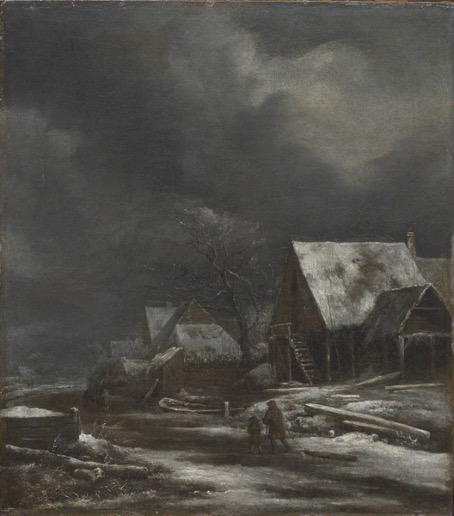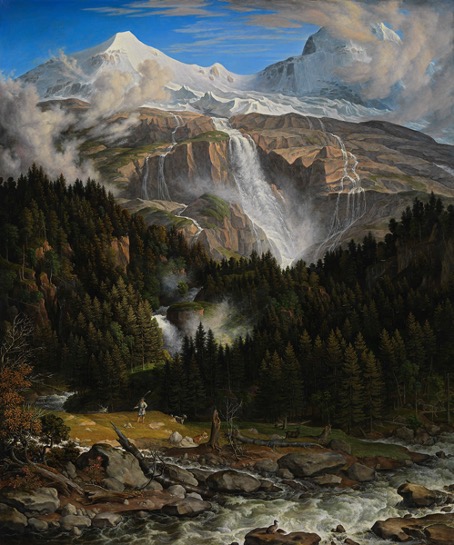—
Archive
Call for Papers: Volume in Brill series „Intersections: Interdisciplinary Studies in Early Modern Culture“ (Ed. by Ulrike Gehring, Andreas Lammer, and Claus Zittel)
Sights of Insight. Meteorological Knowledge between Observation and Theory
Meteorological phenomena are complex sets of causal interaction and interdependent conditions, themselves incessantly shifting. While some of these can be observed and described in detail, many cannot be examined directly. Too far away is the rainbow, too transitory is the flash of lightning, too quickly travelling is even the cloud. Those in history who tried to grasp the meteôra and their causes often resorted to hypotheses or openly acknowledged the intrinsic difficulty of their endeavours.
In meteorology, the epistemological issue of inferring universal knowledge from individual observations is often a trap: even if someone could compare two or more storms, flashes, raindrops, or rainbows, which occurred at one place, no one could be sure that the conditions elsewhere led to the same result, e.g., at the coast compared to the city, a mountain peak compared to the woods. Hence, one commonly finds in literature both the claim that local climate depends on topographical conditions and the advice to study local conditions before drawing inferences from the particular to the universal.
As events, meteorological phenomena are singular due to the high complexity of their conditions and dispositions that lead to their formation. They are not merely influenced but formed by their regional conditions and prefigured by the location of their observation. It was modern instruments and developments in communication technology, among other things, that increasingly helped to escape this trap. In pre-modern times, however, such assistance was not available; other means had to be sought to take up the challenge.
Nonetheless, the number of variously trained, or self-proclaimed, weather experts has always been considerable: depending on their interests or administrative assignments, chroniclers recorded selected cases of extreme events; seafarers captured changes in the local weather in their logbooks; farmers noted their observations regarding their lands and regions; artists drew the weather conditions they had observed on a given day over the low horizon of the sea aided by memory, sketches, and scribbled notes. The list could go on.
At the juncture between the meteorological phenomenon as an explanandum, the record as an interpretandum, and the emerging theory as an explanans, natural philosophers throughout history referred to, and actively sought, the expertise of eyewitnesses, i.e., of professionals, practitioners, and artists, as their observations and experience had a bearing on the theoretical account. Yet, although the transition from apprehending to comprehending, from experiencing to explicating could appear to be seamless in meteorological history, contributors were dependent on transferring their observed singular events into a systematic context by abstracting from the vantage point of their own individual location: the open sea, the summit, the coast, the harbour, or also the studiolo, the library, the atelier, the cloister, or the cathedra – each of these places is considered a site of insight that influenced, prefigured, shaped, and determined in its own very particular way the act of understanding meteorological phenomena.
The point of departure of this interdisciplinary book project on the history of meteorology is the premise that the observation and explanation of meteorological phenomena were intrinsically tied to singular events and places, and that the mere nature of the meteôra made it difficult to generalise the findings, to forge a scientifically adequate theory. The book project therefore aims to identify sites where persons performed individual or systematic weather observations and focus on the ways in which their practices as well as the resulting insights are related to the geographical or architectural site where they were conducted and gathered.
By “practice” we intentionally mean a wide range of operations and activities relevant to the acquisition of meteorological knowledge and experience including observation (with or without instruments), description, teaching, depiction, recording, painting, learning, and reading alongside building and navigating (at mobile sites such as ships and vessels), sowing and hunting (e.g. crops and animals), and others. While further “hotspots” of insight that exerted a similar influence on the meteorological reflection are to be identified, exchanges between or among these, i.e., the transition and transmission of data from one place to another, as well as conducive and/or detrimental effects, are likewise welcome avenues of investigation. Another key element is the conviction that empirical observations and artistic representations of local meteorological events in literature, art, or theatre have the same explanatory potential as natural philosophical models or scientific experiments. That this is, indeed, the case will be shown not merely by reconstructing the exchange between natural philosophers, artists, and practitioners, but by relating the propria of their locations of activity and their sites of insight.
The temporal framework of the book project deliberately goes beyond the early modern period and includes ancient, late antique, and medieval perspectives of the Latin and Arabic world as well as “sites of intellection” in the 18th century, when meteorology underwent a fundamental methodological renewal. It will showcase and scrutinise different forms of written and pictorial representations of, and reflections on, meteorological phenomena as attempts of scientific explanation and understanding, analysed with jointly developed methods from the history of philosophy, art, and literature.
Aiming at a more nuanced understanding of developments within the history of science beyond common temporal boundaries, the focus will be on two complementary processes of transmission: those that transfer ancient ideas into early modern concepts of knowledge, and those that give rise to new insight through their written and/or pictorial forms.
Potential questions to be addressed may include, but are not limited to, the following: Which sites of meteorological knowledge production can be identified over the centuries? / How do these sites affect or influence knowledge, observation, or the form of recording and notation? / Are there particular sites and locations that prefigure to what extent obtained knowledge gains acceptance in one community (or other communities)? / Are there unique features of certain sites that make the obtained or taught knowledge special? Can such knowledge be transmitted or transferred to other locations? / Which locations support or inhibit the transfer of meteorological knowledge? / Which sites of meteorological knowledge feature themselves in texts, images, or maps? / What relations between site and format can be discerned? / Which sites of meteorological knowledge production are literary or visual fiction? / Which sites “archive” meteorological knowledge? etc.
Potential sites that might be worth investigating may include, but are not limited to, the following: atelier, studio / boat, ship, vessel / sea, harbour, port / shipyard, dock / mountain, summit / coast, forest, garden / studiolo, office, scriptorium / laboratory / observatory / cave / library / cloister, abbey, convent / cathedra, academic chair, lecture hall etc.
Submission Information:
- Editors: Ulrike Gehring / Andreas Lammer / Claus Zittel
- Contact: gehring@uni-trier.de / andreas.lammer@ru.nl / claus.zittel@ts.uni-stuttgart.de
How were meteorological phenomena depicted and explained in Greek and Latin antiquity, Greek and Syriac late-antiquity, the Arabic and Latin Middle Ages, or in the Early Modern Period? Can we identify a continuous story? What were the major developments?
We meet regularly in the form of a research colloquium to discuss these and other questions in an interdisciplinary group with senior and junior guests and colleagues, aiming to build up an international working group devoted to the pre-modern history of meteorology.
[Winter Break: We will meet again in Summer 2023]
| Date | Topic | Speaker |
| 28.01.2022 | Franziska Hilfiker: Sea Spots. Perzeption und Repräsentation maritimer Räume im Kontext der englischen und niederländischen Exploration um 1600 | [Reading Session] |
| 14.01.2022 | Nautical Handbooks in Antiquity: The Rediscovery of a Subgenre of Ancient Technical Literature | Boris Dunsch (Marburg) |
| 17.12.2021 | Silver, Salt, and the Sea: Peter Paul Rubens and the global world of early seventeenth-century Antwerp | Christine Göttler (Bern) |
| 10.12.2021 | Atlantis um 1850. Spuren und Spekulationen zur Geschichte des Lebens | Robert Felfe (Graz) |
| 12.11.2021 | Maritime & Mathematical Expertise at Trinity House in the 17th and 18th Century | Rebekah Higgitt (Edinburgh) |
| 09.07.2021 | Die Darstellung von Seesturm und Schiffbruch im Goldenen Zeitalter der Niederlande, Teil 2 | Gerlinde de Beer (Hamburg) |
| 18.06.2021 | Olympiodore et le commentaire aux Météorologica: amicus Aristoteles, amicus Plato sed magis amica veritas | Christina Viano (Paris) |
| 11.06.2021 | Die Darstellung von Seesturm und Schiffbruch im Goldenen Zeitalter der Niederlande, Teil 1 | Gerlinde de Beer (Hamburg) |
| 21.05.2021 | Vows on Water: Ship-Ex-voto as Things, Metaphors, and Mediators of Communality | Hannah Baader (Florenz) |
| 14.05.2021 | Meteopoetics, Literary Meteorology, Meteopoetology: A Historical and Systematic Distinction in Literary Presentations of Weather | Urs Büttner (Düsseldorf) |
| 16.04.2021 | Pierre Gassendi’s Meteorology: Humanism, History, and Observation | Craig Martin (Venedig) |
| 09.04.2021 | Form and Function of the Medieval Map | Pascal Arnaud (Lyon) |
| 12.03.2021 | Weather Observation in Late Antiquity and Medieval Times | Thomas Wozniak (Stuttgart | Tübingen) |
| 26.02.2021 | Metaphysics of Meteorology | Malcolm Wilson (Oregon) |
| 19.02.2021 | Coping with Maritime Risks in Antiquity | Christian Rollinger (Trier) |
| 05.02.2021 | Early Peripatetic Treatments of Wind (ἄνεμος, πνεῦμα) | Robert Mayhew (Seton Hall, NJ) |
| 29.01.2021 | Schneekristalle, Wind und Wolken (…) Erklärungen in Descartes Météores) | Claus Zittel (Stuttgart I Venedig) |
| 22.01.2021 | Compass Presentation | Die Carta Marina (1539) | Jannik Eikmeier (Trier) |
Since 2019 Ulrike Gehring (Art History) and Andreas Lammer (Philosophy) invite international colleagues, in order to jointly reflect on the history of meteorology, both in philosophical and scientific texts and in pieces of art, in diagrams, and in literature.
Please find below lists of our guests since 2019 to download.

Online-seminar by students for students:
›The Colour of Snow‹
Every Wednesday, 6-7pm, online-registration here | In German
A cooperation of „Die Pinakotheken“ Munich, the Department of Literature, Art and Media Studies at the University of Konstanz and the Department of Art History at the University of Trier
For many centuries, snow and ice landscapes were perceived primarily as hostile spaces. This changed with the increasing exploration and study of the frozen ‚element‘ in the 17th century. Scientific, literary and pictorial studies describe the fascinating dendrite structure of crystals, examine the sound of snowfall and trace landscapes that lose their topographical features under the sparkling white but at the same time contrastless blanket of snow.
Starting with one work each from the Bavarian State Painting Collections, students from the Universities of Constance and Trier will focus on one thematic area for six weeks. With the help of relevant treatises and on the basis of various artistic positions, they will explore the question of the extent to which a deeper understanding of snow has led to an aesthetic reassessment of it. Alongside wintry pictorial examples from the early modern period and the artistic representation of snow and ice in early Romanticism, variations on the snow motif in contemporary art will be addressed. The conquest of the Alpine world will be discussed as well as the loss of snow in times of global warming. In painting, literature and film, the perilous ‚element‘ will be traced over the different centuries and its sensual beauty in form and colour will be made recognisable.
Following a brief introduction to the initial work of the event by selected art educators from the Bavarian State Painting Collections, students from the universities of Trier and Constance will present a specific thematic area of winter depictions. The curator Larissa Wesp will draw a connection to a contemporary work and conclude with a stimulating moderated discussion.
More information.



Always up to date
Make sure to check out the activities of TRANSMARE (Trier University) as well: